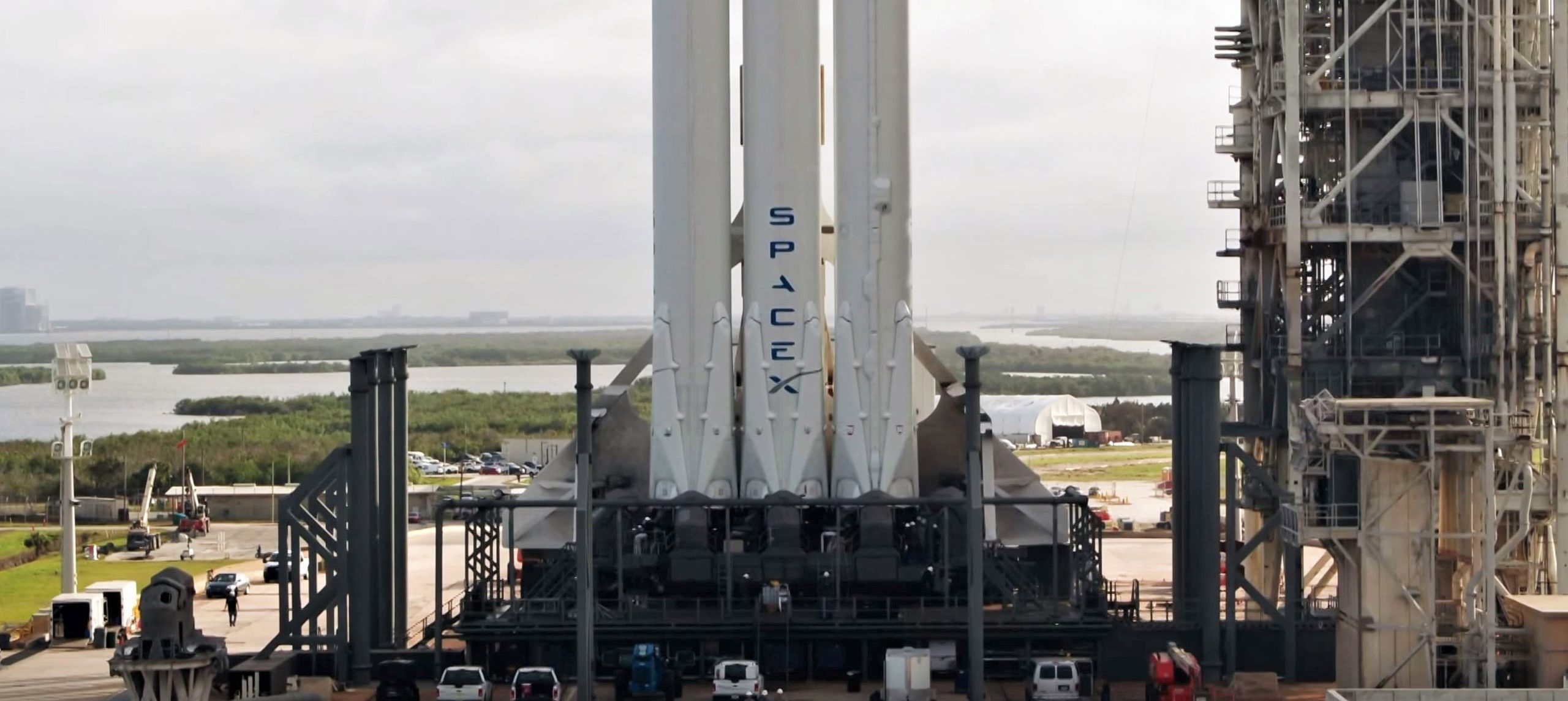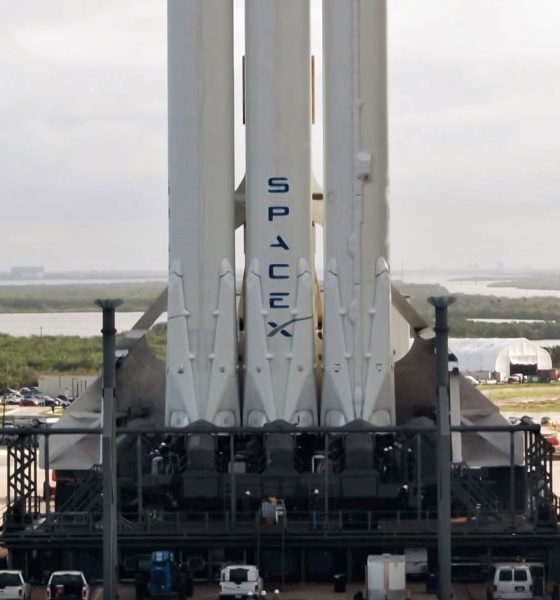The first commercial launch of SpaceX’s Falcon Heavy rocket – this time in a Block 5 configuration – is as few as ten days away from a targeted window beginning at 6:36 pm EST (22:36 UTC), April 7th. That target hinges on whether Falcon Heavy is ready and able to roll out to Pad 39A and successfully conduct its first integrated static fire, currently scheduled on April 1st.
The payload for this mission – communications satellite Arabsat 6A – had its original Lockheed Martin manufacturing and SpaceX launch contracts signed back in the first half of 2015, while the 6000 kg (13,200 lb) spacecraft was effectively completed once it was shipped from California to Florida at the start of 2019. After approximately 12 months of delays from an original launch target shortly after Falcon Heavy’s 2018 debut, Arabsat 6A’s four-year journey will hopefully reach completion in a geostationary transfer orbit. At the same time, the US Air Force says that it will be watching this launch – and the one meant to follow soon after – as a critical test along the path to fully certifying the powerful rocket for military launches.
As a pathfinder for an unproven rocket, SpaceX’s first Falcon Heavy launch suffered a number of likely minor to moderate anomalies as company engineers and technicians learned for the first time how the rocket actually behaves in the real world, under real-world conditions and operations. Case in point, the first integrated Falcon Heavy was taken through its first wet-dress rehearsal – in which the vehicle is filled with a
Despite the invaluable experience gained by those orchestrating the launch and those who built the vehicle, Falcon Heavy’s second launch may result in similar teething pains, particularly due to the fact that the rocket’s complete upgrade to Block 5 hardware likely necessitated significant design changes across the board. In other words, the rocket SpaceX aims to launch in early April may be quite a bit different from the vehicle that launched 14 months prior, creating much of the same uncertainty inherent in the first launch(es) of any new rocket. Still, many of the complex boosters’ connection and separation mechanisms that were flight-tested for the first time that February 
“Again, I don’t want to tempt fate. But this is a much stronger octaweb structure. It’s made of
“Biggest process change [for Block 5] was eliminating Tig welding of the thrust structure or “Octaweb” and the move to a bolted design but this made it much easier and faster to produce overall as well.” – SpaceX VP of Production Andy Lambert, April 2018
A step further, SpaceX CEO Elon Musk has indicated that one major section of Block 5 upgrades – moving from a welded to a bolted thrust structure (i.e. octaweb) – was expected to be a boon for Falcon Heavy, while also making octawebs far easier to manufacture, assemble, and even disassemble. According to Musk, new bolted octawebs are also “dramatically” stronger, a boon for Falcon Heavy boosters – particularly the center core – that need to survive forces multiple times stronger than those subjected upon Falcon 9 first stages.

Meanwhile, according to comments made by Air Force officials to Spaceflight Now, the USAF is looking at SpaceX’s Arabsat 6A and subsequent STP-2 Falcon Heavy launches as critical steps along the way to fully certifying the rocket for valuable military payloads. Currently, the only option available for military and NRO payloads past a certain weight or in need of exceptionally high-energy orbits is ULA’s Delta IV Heavy rocket, an extremely expensive ($300M+ per launch) rocket with a bad track record of schedule reliability.
An Air Force spokesperson this week confirmed the agreement to use previously-flown side boosters for the STP-2 mission. The center core will be new for the Arabsat 6A and STP-2 launches.
“This provides an early opportunity for the Air Force to understand the process for using previously-flown hardware with the goal to open future EELV missions to reusable launch vehicles,” the spokesperson said in response to an inquiry from Spaceflight Now.
SpaceX’s Falcon Heavy rocket could launch on its first commercial flight as soon as April 7. SpaceX will re-fly the side boosters on a Falcon Heavy launch this summer in a key demonstration for the Air Force to move closer to certifying reused rockets. https://t.co/guc7yaE7sH pic.twitter.com/FyaIS3Mlnf— Spaceflight Now (@SpaceflightNow) March 16, 2019
Given that STP-2 will need to reuse both of the Arabsat 6A Falcon Heavy’s side boosters, the USAF official also specifically noted that the military branch would be examining SpaceX’s refurbishment processes and the performance of the flight-proven stages with the intention of ultimately allowing reused rockets to launch military satellites. As such, the successful launch, landing, refurbishment, and re-launch of both Falcon Heavy side boosters (B1052 & B1053) will be doubly critical for SpaceX.
Check out Teslarati’s Marketplace! We offer Tesla accessories, including for the Tesla Cybertruck and Tesla Model 3.

Elon Musk
Elon Musk’s Biggest Revelations on AI, Robots, and the Future of Work from the Moonshots Podcast

Elon Musk’s appearance on the Moonshots with Peter Diamandis podcast was packed with bold predictions, candid admissions, and surprising tech insights. The nearly three-hour conversation covered everything from artificial intelligence to humanoid robots, geopolitics, and the future of work. Here are the top 10 most intriguing takeaways:
-
Aggressive AGI Timeline Predictions
Musk offered a detailed view on when artificial general intelligence (AGI) could emerge, suggesting it may arrive sooner than many expect, emphasizing both transformative potential and risks.
-
U.S. vs. China in the AI Race
He discussed the strategic competition between the United States and China over AI development, noting that geopolitical dynamics will shape how and who leads in the next decades.
-
Future of Job Markets
Musk touched on how AI and automation could reshape employment, predicting massive boosts in productivity alongside potential disruptions in traditional work structures.
-
Clean Energy Transition
A recurring theme was the role of clean energy in future economies, with Musk reiterating the importance of scaling sustainable power generation and storage.
-
Humanoid Robots Are Coming
On the podcast, Musk elaborated on Tesla’s work on humanoid robots, hinting at timelines and applications that go beyond factories to general-purpose assistance.
-
Tesla Roadster “Last Human-Driven Car”
Outside the core discussion topics, Musk teased features of the upcoming Tesla Roadster — calling it “the best of the last of the human-driven cars” and suggesting safety won’t be its main selling point.
-
The Role of AI in Clean Energy and Robotics
Linking AI to both energy optimization and robotics, Musk explained how smarter systems could accelerate decarbonization and task automation across industries.
-
U.S. Innovation Leadership
Musk argued that maintaining American leadership in key tech sectors like AI, space, and robotics should be a national priority, with thoughtful policy and investment.
-
Job Creation vs. Job Elimination
While acknowledging automation’s disruptive effects, he also outlined scenarios where new industries and opportunities could emerge, particularly in AI, space, and advanced manufacturing.
-
Long-Term Vision for Humanity
Throughout the conversation, Musk revisited his long-term philosophical views — including a belief in humanity’s responsibility to become a multi-planetary and technologically empowered species.
Whether you agree with Musk’s optimism or not, the podcast offers a window into the thinking of one of the most influential figures in tech today, in and why his visions continue to spark debate and inspiration.
Elon Musk
Starlink achieves major milestones in 2025 progress report
Starlink wrapped up 2025 with impressive growth, adding more than 4.6 million new active customers and expanding service to 35 additional countries, territories, and markets.

Starlink wrapped up 2025 with impressive growth, adding more than 4.6 million new active customers and expanding service to 35 additional countries, territories, and markets. The company also completed deployment of its first-generation Direct to Cell constellation, launching over 650 satellites in just 18 months to enable cellular connectivity.
SpaceX highlighted Starlink’s impressive 2025 progress in an extensive report.
Key achievements from Starlink’s 2025 Progress
Starlink connected over 4.6 million new customers with high-speed internet while bringing service to 35 more regions worldwide in 2025. Starlink is now connecting 9.2 million people worldwide. The service achieved this just weeks after hitting its 8 million customer milestone.
Starlink is now available in 155 markets, including areas that are unreachable by traditional ISPs. As per SpaceX, Starlink has also provided over 21 million airline passengers and 20 million cruise passengers with reliable high-speed internet connectivity during their travels.
Starlink Direct to Cell
Starlink’s Direct to Cell constellation, more than 650 satellites strong, has already connected over 12 million people at least once, marking a breakthrough in global mobile coverage.
Starlink Direct to Cell is currently rolled out to 22 countries and 6 continents, with over 6 million monthly customers. Starlink Direct to Cell also has 27 MNO partners to date.
“This year, SpaceX completed deployment of the first generation of the Starlink Direct to Cell constellation, with more than 650 satellites launched to low-Earth orbit in just 18 months. Starlink Direct to Cell has connected more than 12 million people, and counting, at least once, providing life-saving connectivity when people need it most,” SpaceX wrote.
Elon Musk
Starlink passes 9 million active customers just weeks after hitting 8 million
The milestone highlights the accelerating growth of Starlink, which has now been adding over 20,000 new users per day.

SpaceX’s Starlink satellite internet service has continued its rapid global expansion, surpassing 9 million active customers just weeks after crossing the 8 million mark.
The milestone highlights the accelerating growth of Starlink, which has now been adding over 20,000 new users per day.
9 million customers
In a post on X, SpaceX stated that Starlink now serves over 9 million active users across 155 countries, territories, and markets. The company reached 8 million customers in early November, meaning it added roughly 1 million subscribers in under seven weeks, or about 21,275 new users on average per day.
“Starlink is connecting more than 9M active customers with high-speed internet across 155 countries, territories, and many other markets,” Starlink wrote in a post on its official X account. SpaceX President Gwynne Shotwell also celebrated the milestone on X. “A huge thank you to all of our customers and congrats to the Starlink team for such an incredible product,” she wrote.
That growth rate reflects both rising demand for broadband in underserved regions and Starlink’s expanding satellite constellation, which now includes more than 9,000 low-Earth-orbit satellites designed to deliver high-speed, low-latency internet worldwide.
Starlink’s momentum
Starlink’s momentum has been building up. SpaceX reported 4.6 million Starlink customers in December 2024, followed by 7 million by August 2025, and 8 million customers in November. Independent data also suggests Starlink usage is rising sharply, with Cloudflare reporting that global web traffic from Starlink users more than doubled in 2025, as noted in an Insider report.
Starlink’s momentum is increasingly tied to SpaceX’s broader financial outlook. Elon Musk has said the satellite network is “by far” the company’s largest revenue driver, and reports suggest SpaceX may be positioning itself for an initial public offering as soon as next year, with valuations estimated as high as $1.5 trillion. Musk has also suggested in the past that Starlink could have its own IPO in the future.










